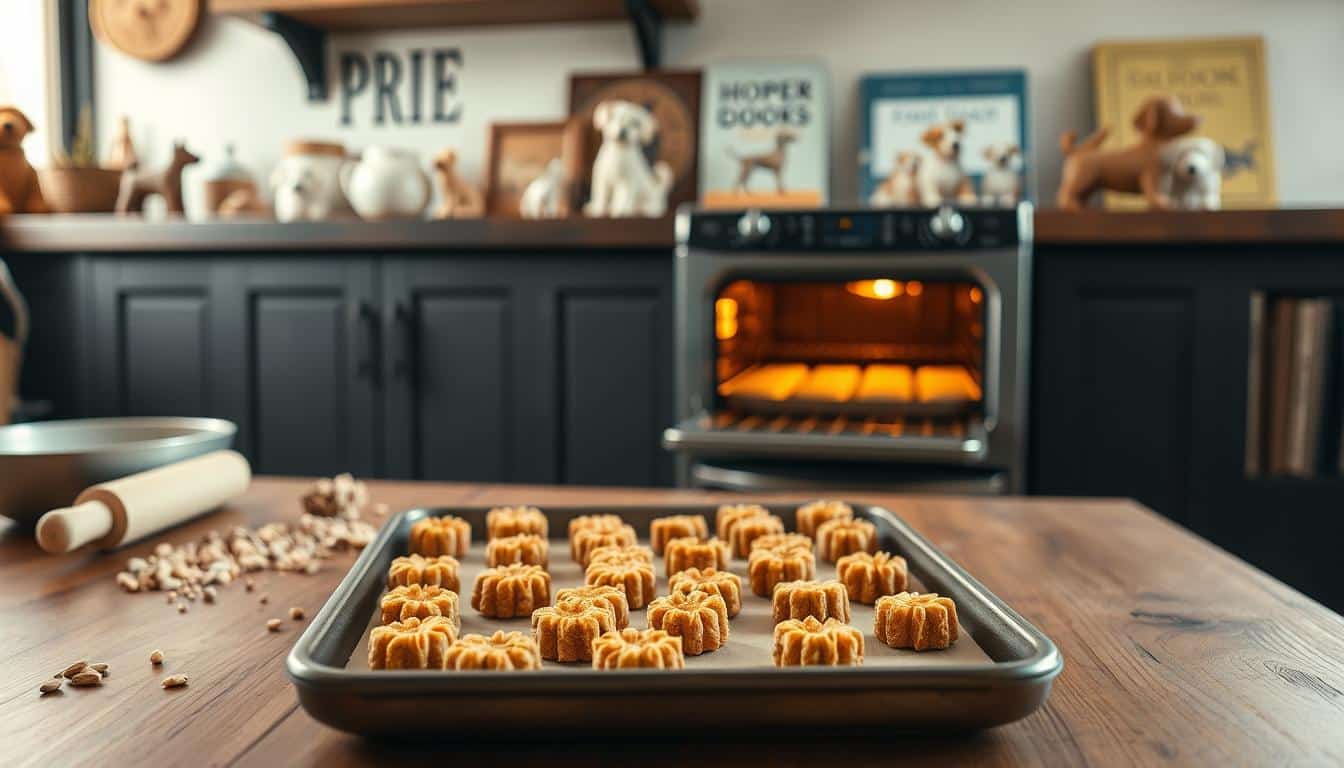Many pet owners see benefits from switching to whole foods-based pet recipes. Experts like those at Tufts Clinical Nutrition recommend such diets. They note that homemade meals can lessen allergies, leading to fewer skin problems and ear infections.
These diets often include uncommon proteins and foods rich in omega-3s. Ingredients like pumpkin and sweet potato provide good fiber. Following these plans with a vet’s guidance can greatly improve your pet’s allergy issues and overall health.
Always consult with a vet or nutrition expert before changing your pet’s diet. They’ll likely suggest a detailed trial to pinpoint allergies. This piece is filled with vet-backed tips and recipes for pets with allergies.
Understanding Pet Allergies and When to Consult Your Veterinarian
Pets may be allergic to many things, like pollen or flea saliva. Some react to food or things in diets that aren’t natural. Finding out what causes the allergy and testing for it can help. This way, your pet can feel better and itch less.
Skin and food allergies in pets can come from things outside or certain foods. For example, flea bites, or protein from beef, chicken, dairy, or soy can cause reactions. If a pet itches all year, it might be food or something inside causing trouble, not just pollen from outside.
Pets might scratch a lot, lose hair, have skin sores, or ear infections from allergies. Some might also have stomach problems, like throwing up or diarrhea, along with skin issues. Watching these signs helps tell apart allergies from other irritations.
Food allergy and intolerance are different. A true allergy involves the immune system reacting to food protein. Intolerance upsets the stomach without involving the immune system. Experts from Tufts say food allergies are rarer than other allergies but are important if symptoms don’t stop.
To find out what’s causing allergies, vets may do tests. But, food tests can be tricky and might not always be right. So, for food issues, vets recommend a special diet with new protein and few carbs for about 6 to 8 weeks. Then, slowly add foods back to see what causes the problem.
- Some good steps include controlling fleas in your home, picking simple foods, and using things like coconut oil wipes for the skin.
- Call your vet if your pet keeps itching, gets ear infections often, scoots, or has stomach issues. They might suggest tests or a special diet to figure out the allergy.
Key nutrients for allergy management: what vets recommend
Vets believe managing allergies in pets starts with the right nutrition. They say certain ingredients can ease inflammation, help digestion, and keep the skin healthy. Here are important nutrients and tips for using them in homemade pet foods, with advice from your vet.
- Fish oil from sardines, salmon, or Icelandic HVB sources supplies EPA and DHA that reduce skin inflammation. Adding measured omega-3 for dogs helps with itching and improves coat shine.
- Plant options such as flaxseed offer ALA, which converts poorly to EPA/DHA but adds anti-inflammatory value when combined with marine oils.
- Use veterinarian-tested dosages. Too much fat can upset calories and digestion, so consult your clinic about supplement brands and amounts.
Lean novel proteins and limited-ingredient approaches
- Novel protein diets use proteins like venison, rabbit, or duck. These options lower prior immune exposure and help isolate triggers during elimination trials.
- Lean meats such as turkey or whitefish keep calories in check while supporting muscle maintenance and skin repair.
- Veterinary nutrition for allergies often favors limited-ingredient recipes to minimize cross-reactivity. A canine premix can help balance micronutrients when using single-protein meals.
Digestive-supporting fiber and prebiotics
- Soluble fibers like pumpkin and sweet potato soothe bowels and feed beneficial microbes. These sources act as prebiotic fiber pets respond well to during transition phases.
- Consistent fiber can reduce stool issues seen in food intolerance and support a healthy gut-skin axis.
- Introduce fiber gradually and monitor stool quality; abrupt changes can cause gas or loose stool.
Vitamins, minerals, and supplements to support skin and coat health
- Essential micronutrients such as zinc, vitamin E, and B vitamins aid skin repair and immune function. Balanced premixes or veterinary guidance prevent shortfalls or excesses.
- Supplements for skin and coat—collagen peptides, biotin, and targeted antioxidants—can complement omega-3 for dogs to improve hair strength and reduce flaking.
- Work with a veterinary nutritionist to confirm nutrient ratios. Over-supplementing can create new problems, so professional oversight is key.
Use these key points to make allergy-friendly meals for your pet. Keep track during food trials, talk to your vet about any changes, and tweak the food as needed based on their advice and test results.
Allergy-friendly recipe principles: vet-approved guidance for homemade meals
When making meals for dogs with allergies, keep it simple. Use one protein source at a time. This helps figure out what causes reactions. It’s important for finding out the cause of allergies.
Start with uncommon meats like rabbit or duck for a while. This method reduces the risk of allergies. It lets you see if certain foods like beef or eggs are problems. Use homemade treats from safe ingredients when you switch foods.
Use fresh fruits, veggies, grains, and lean meats, just like in the Pet-iterranean diet. This diet helps with skin health. You can use a vet-recommended supplement to ensure all nutrients are included.
It’s key to balance the nutrients in your dog’s diet. Start by feeding 2% of their body weight each day. Change the amount based on their health and activity. Always check with a vet nutritionist for specific dietary needs.
- Protein priority: pick one novel protein for the elimination phase.
- Healthy fats: include omega-3 sources like salmon oil to reduce inflammation.
- Carbohydrate choices: use gentle options such as sweet potato, quinoa, or brown rice.
- Fiber and gut support: add pumpkin or green banana for digestion.
Don’t forget about getting the right vitamins and minerals. Homemade meals need the right balance. A vet-approved supplement can ensure meals stay healthy over time.
Avoid foods that are toxic to dogs. This includes chocolate, grapes, and onions, among others. Always check the ingredients of what you’re using. And stay away from flavored broths that might have hidden allergens.
Go slow when changing your dog’s diet. Introduce new foods gradually. Watch how they react, especially their skin and stomach. If problems pop up, talk to your vet about what to do next.
Allergy-friendly recipes your vet will love
Here are four vet-recommended recipes that focus on special proteins, easy-to-digest carbs, and omega-3s for pets with allergies. These recipes are easy to make and cool before serving. They should be tailored to your pet’s size and activity level. You can freeze single servings for quick meals.
Turkey and Sweet Potato Delight
- Ingredients: lean ground turkey, mashed sweet potato, peas, small drizzle of olive oil.
- Notes: This recipe helps with digestion and avoids common allergens. Fully cook the turkey, mix with cooled sweet potato, and add peas.
- Portion tip: Serve 1/2 to 1 cup per 10 pounds, adjusting as needed and following vet advice.
Salmon and Quinoa Medley
- Ingredients: flaked cooked salmon, cooked quinoa, steamed carrots, green beans, a splash of fish oil after cooling.
- Notes: This meal provides skin-helping omega-3s and a soft grain base. Add fish oil after cooling to keep it healthy.
- Portion tip: Lessen quinoa if your dog is grain-sensitive; talk to your vet about supplements.
Venison and Sweet Pea Blend
- Ingredients: diced venison, peas, cooked quinoa, a teaspoon of coconut oil for taste.
- Notes: The venison recipe is great for dogs on elimination diets. It’s made with few ingredients for easy allergy tracking.
- Portion tip: Use this during vet-monitored trials; change only if it’s okay.
Whitefish and Carrot Mix
- Ingredients: flaked whitefish, mashed carrots, cooked brown rice, a small dose of fish oil after cooling.
- Notes: This whitefish meal is good for dogs with food allergies, supporting stomach and skin health. Make sure fish is well-cooked and bone-free.
- Portion tip: Begin with tiny amounts to check for reactions before giving more.
These DIY hypoallergenic meals are based on vet-advised rules: unique proteins, few ingredients, and omega-3s for skin health. For long-term diets, add a vet-approved supplement or get advice from a pet nutritionist to cover all nutritional needs.
Hypoallergenic treats and training rewards for sensitive dogs
Training with small rewards encourages good behavior. For dogs with sensitivities, choose treats that are safe for them. Also, make sure snacks don’t go over their daily calorie limit. Gradually introduce new treats and keep an eye on your dog’s health signs.
Sweet Potato Pie Allergy-Free Dog Treats using brown rice flour
These treats are made with brown rice flour, preventing egg or dairy allergy triggers. Mix 2 1/2 cups of the flour, 3/4 cup mashed baked sweet potato, and some cinnamon and ginger. Use 3 tablespoons of aquafaba or 1/2 cup unsweetened applesauce as binders. Add water until you have a stiff dough, roll it out, cut shapes, and bake at 350°F until done. Cool them down before letting your dog try them.
Keep these treats in the fridge in a sealed container for up to three weeks. You can also freeze them for longer storage. Thaw them before training so they’re soft for your dog.
Meaty Dry Dog Treats for protein-only reward options
For single-ingredient rewards, try meat-only treats during elimination diets. Cook a pound of lean ground meat, blend it smooth, then remove any extra liquid. Put small dots on a baking sheet and either dehydrate or bake at 150°F for 6-8 hours until they’re dry.
These meat treats are great for training. Because they’re pure protein, use them in moderation. Check with your vet to make sure your dog’s diet stays balanced.
Treat ingredient swaps for egg, wheat, and dairy allergies
- Egg alternatives: try aquafaba, mashed banana, or applesauce, depending on your dog’s needs.
- Instead of wheat, use brown rice flour, oat flour, or chickpea flour if your dog’s okay with legumes.
- For dairy-free options, use plain pumpkin, canned puree, or specific wet foods.
Be careful with treats for dogs with allergies. Watch out for hidden stuff like added flavors or seasonings. Stay away from anything with onion, garlic, or too much salt. Always check with your vet before trying new treats during an elimination diet.
Storage, shelf life, and safe introduction of new treats
How you store treats can affect their freshness and safety. Keep baked or dry treats in tight containers in the fridge or freezer. Make sure to label them with dates and switch them out regularly to avoid any from going bad, especially those with added oils.
- Try one new treat at a time, over a week.
- Start with small portions and watch your dog for any bad reactions.
- Stop all treats during an official elimination diet unless your vet says it’s okay.
Always talk to your vet when choosing treats for allergic dogs. They can help you find the best ones for your pet’s allergies. They’ll also suggest safe options for training that won’t harm your dog’s health.
How to transition your pet safely to homemade allergy-friendly diets
Switching a pet to homemade meals requires planning. Define your goal and timeline first. Keep track of your pet’s skin, ears, stools, energy, and eating habits. These notes help detect changes during the switch.

Begin with a slow transition to avoid stomach upset. Start by mixing a little of the new food with their current one. Over 7–10 days, gradually increase the homemade part. This careful method helps prevent vomiting, diarrhea, or your dog turning their nose up at the food.
Gradual switching protocols to avoid digestive upset
Introduce 10% of the new food on the first day. Then, increase to 25% by day three and 50% by day five. By day seven, go up to 75%, aiming for 100% by day ten if your pet is doing well. If they show signs of upset, slow down or pause the switch. Extra care may be needed for older or sensitive pets.
Monitoring response during an elimination trial (6–8 weeks guidance)
Conduct an elimination diet for 6–8 weeks if you suspect a food allergy. Feed your pet a new protein and a simple carbohydrate. Avoid any extras like treats or human food. Watch and note how your pet improves each week.
- Note skin changes: less scratching, fewer hot spots.
- Watch ear health: reduced redness, odor, or discharge.
- Log GI signs: formed stools and consistent appetite.
When to reintroduce foods and how to identify triggers
If your pet gets better during the elimination phase, start adding foods back one at a time. Introduce a new protein for 5–7 days and see if symptoms return. Keep a written record to keep the tests clear.
- Begin with small amounts and watch the reaction for 48–72 hours.
- If a reaction occurs, stop. Record it, then let your pet recover before trying another food.
- Reintroduce the food after recovery to double-check if it’s a trigger.
Working with your veterinarian or a veterinary nutritionist for balanced recipes
It’s crucial to talk to a veterinarian from the start. If you’re planning on feeding your pet homemade meals for a while, consult a veterinary nutritionist. They’ll make sure your pet gets the right vitamins, minerals, and calories. Missing nutrients can lead to problems with their skin, coat, and overall health.
Follow feeding guides based on your pet’s weight to determine meal sizes. Remember, calorie needs can differ up to 50% between pets. Regular visits with your vet allow for safe adjustments as you switch to homemade dog food.
Practical meal-prep tips, portioning, and storage for busy pet parents
When life gets busy, you need an easy plan for pet meals. Cooking in big batches saves time and makes sure meals are the same size. Always cool food before serving. Quickly store any leftovers to keep them fresh. Remember to mark all meals clearly with the date and kind of protein. This helps you keep track and see how your pet handles different foods.
- Cook lots in an Instant Pot or oven. The Instant Pot’s natural venting keeps the food moist, which is great for pets with stomach issues.
- While still warm, divide meals into single servings, then cool them before sealing. This helps you quickly choose the right amount daily.
- For long-term storage, label and freeze the homemade food. Use tight-sealing containers and keep frozen for up to three months to ensure quality.
Thawing and reheating
- Thaw meals overnight in the fridge or quicker in a cold-water bath. Avoid refreezing food once it’s thawed.
- Add omega-3 rich oils like fish oil after cooling. This keeps the nutrients intact and stops the oils from spoiling.
- When heating food, stir well and check it’s not too hot to prevent burns.
Portion guide and feeding ranges
Start with a trusted guide for homemade dog meals. These feeding amounts consider weight and energy needs. Change the amounts based on how active your pet is, their age and health.
- 5–10 lb: 1/2–1 cup per day
- 11–25 lb: 1–3 cups per day
- 26–50 lb: 3–5 cups per day
- 51–75 lb: 5–7 cups per day
- 75–100 lb: 7–10 cups per day
The calories in meals can differ a lot. Watch your pet’s weight and adjust food amounts to keep them healthy.
Bone broth and supplemental oils
- Bone broth is full of nutrients and makes a great addition. Roast bones, then simmer them long hours. Strain out solids before giving the tasty broth in small amounts.
- Bone broth can make meals more exciting or help with keeping your pet hydrated. But it should not replace meals.
- Add oils like fish oil after the meal cools. Just make sure to use the right amount to avoid health issues and weight gain.
Labeling, rotating proteins, and hygiene
- Always mark containers with the date and protein. Switching proteins offers variety and helps find any food sensitivities.
- If testing for allergies, keep to one protein until the trial is done.
- Avoid mixing equipment for different proteins to stop contamination. Always clean and sanitize kitchen tools after use.
By following these tips, making meals for your dog becomes easier. Proper portion sizes, freezing practices, and cleanliness minimize health risks. These steps are especially important for pets with allergies or dietary needs.
Solutions for common allergy scenarios: tailored recipe suggestions
Pets with skin or digestive issues can benefit from specific recipes. These recipes ease inflammation and fulfill their nutritional needs. Your vet can guide you on using unique proteins for dogs and choosing whole foods to lower reaction risks. They help with issues like chronic ear problems, stomach sensitivities, managing weight in allergic pets, and diet’s impact on flea or environmental allergies.
-
Chronic ear infections and skin inflammation
For fewer immune reactions, pick novel proteins like venison, rabbit, or duck. Venison & Sweet Pea and rabbit with pumpkin recipes add soluble fibers. These fibers help calm the stomach and skin. Adding bone broth makes food tastier and supports digestion while on a limited-ingredient diet.
-
Gastrointestinal intolerance
Choose dog foods or make meals that are kind on the GI tract, featuring gentle carbs and soluble fiber. Ingredients like sweet potato, pumpkin, and soft-cooked white rice ease irritation. During elimination trials, stick to one protein type and few ingredients to identify allergens faster.
-
Overweight pets with allergic skin disease
Focus on a diet that helps allergic dogs lose weight while offering lean protein and veggies low in calories. Options include turkey, skinless chicken, and various novel proteins. Portion control and adding omega-3 oil helps fight inflammation without added calories.
-
Flea- and environment-driven skin issues vs true food allergy
When symptoms are seasonal or localized, consider external solutions and vet care first before changing diets. Only add a flea allergy diet as support if your vet suggests it. For constant symptoms, try an elimination diet with GI-friendly or limited-ingredient foods to check for food allergies.
Work closely with your vet or a nutrition specialist during diet trials. Track symptoms, food components, and how much your pet eats. This helps tailor the diet with choices like novel proteins, flea allergy management, or a weight loss plan for allergic dogs based on outcomes.
Conclusion
Making meals at home can help your pet feel better by avoiding triggers found in store-bought food. These homemade dishes have things like omega-3s and fiber that are great for your pet. Recipes that your vet recommends often use less common proteins and fresh ingredients to help reduce swelling and keep your pet’s coat shiny.
Taking a Pet-iterranean diet approach means feeding your pet whole foods with limited fats and including fish oil. This can lead to better skin and more energy. It’s important that any homemade food you make is checked by a vet. They ensure your pet gets all the nutrients it needs and help figure out if your pet has a food allergy or just an intolerance.
Starting with a 6–8 week diet of new proteins can pinpoint what your pet may be allergic to. Introduce special diet items and treats slowly and keep an eye on how your pet reacts. Working closely with a vet is key. They’ll help you find what causes issues, keep your pet at a healthy weight, and develop a safe and effective diet plan.
FAQ
What are the most common causes of skin and food allergies in pets?
What signs should prompt a vet visit for suspected allergies?
How is food allergy different from food intolerance?
What is the gold‑standard diagnostic approach for food allergy?
Which nutrients are most important for managing allergic skin disease?
Should I add supplements to homemade allergy‑friendly meals?
What is a “limited‑ingredient” or “novel‑protein” diet and when is it useful?
Can homemade “Pet‑iterranean” style meals help allergic pets?
What are safe human foods to include and which to avoid?
Can homemade diets reduce flea‑allergy or environmental allergy symptoms?
How do I portion homemade meals for my dog?
How should I transition my dog from commercial food to homemade recipes?
How long should an elimination trial last and what does reintroduction look like?
Are homemade allergy‑friendly recipes nutritionally complete?
What are some vet‑friendly homemade recipe examples for allergic dogs?
Can I give homemade treats during an elimination diet?
How should I store batch‑cooked meals and homemade treats?
What role do bone broth and supplemental oils play?
When should I consult a veterinary dermatologist or nutritionist?
How can I minimize cross‑contamination during elimination trials?
Content created with the help of Artificial Intelligence.



